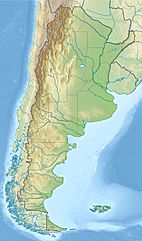Pinturas River facts for kids
Quick facts for kids Pinturas River |
|
|---|---|

Pinturas River as it flows through the Pinturas River Canyon.
|
|
|
Location of mouth
|
|
| Country | Argentina |
| Province | Santa Cruz |
| Physical characteristics | |
| River mouth | 46°34′59″S 70°18′00″W / 46.583°S 70.300°W |
| Basin features | |
| Tributaries |
|
The Pinturas River is a cool river in Patagonia, Argentina. Its name means "Painted River" or "River of Paintings" in Spanish. This is because of all the amazing ancient rock art found nearby. The river flows through a deep valley called the Pinturas River Canyon. Close by is the famous Cueva de las Manos, a cave with ancient handprints. The Ecker River flows into the Pinturas River. The Pinturas River then joins the larger Deseado River.
Contents
Where is the Pinturas River?
The Pinturas River is located in the southern part of Argentina. It flows through the Santa Cruz Province. This area is known for its wide-open spaces and unique landscapes.
How does the Pinturas River flow?
The Pinturas River starts high up in the Andes Mountains. It begins near a small mountain called Mount Zeballos. The river first flows towards the east for about 100 kilometers (62 miles).
The Pinturas River Canyon
After a while, the river turns and heads north. It then enters the amazing Pinturas River Canyon. This canyon is a very deep and narrow valley. The river and the canyon stretch for about 150 kilometers (93 miles). The river flows at about 240 meters (787 feet) above sea level here.
Joining the Deseado River
The Ecker River is the main river that flows into the Pinturas River. After its long journey through the canyon, the Pinturas River finally flows into the Deseado River.
Why is the Pinturas River famous?
The Pinturas River is most famous for the many ancient sites along its banks. These sites have incredible rock art. This is why its name means "Painted River" or "River of Paintings."
Cueva de las Manos
The most well-known site is Cueva de las Manos. This name means "Cave of the Hands" in Spanish. It is a World Heritage Site, which means it's very important to the whole world. Inside the cave, you can see hundreds of ancient handprints painted on the walls. These paintings are thousands of years old! They show us how people lived long, long ago.
See also
 In Spanish: Río Pinturas para niños
In Spanish: Río Pinturas para niños



